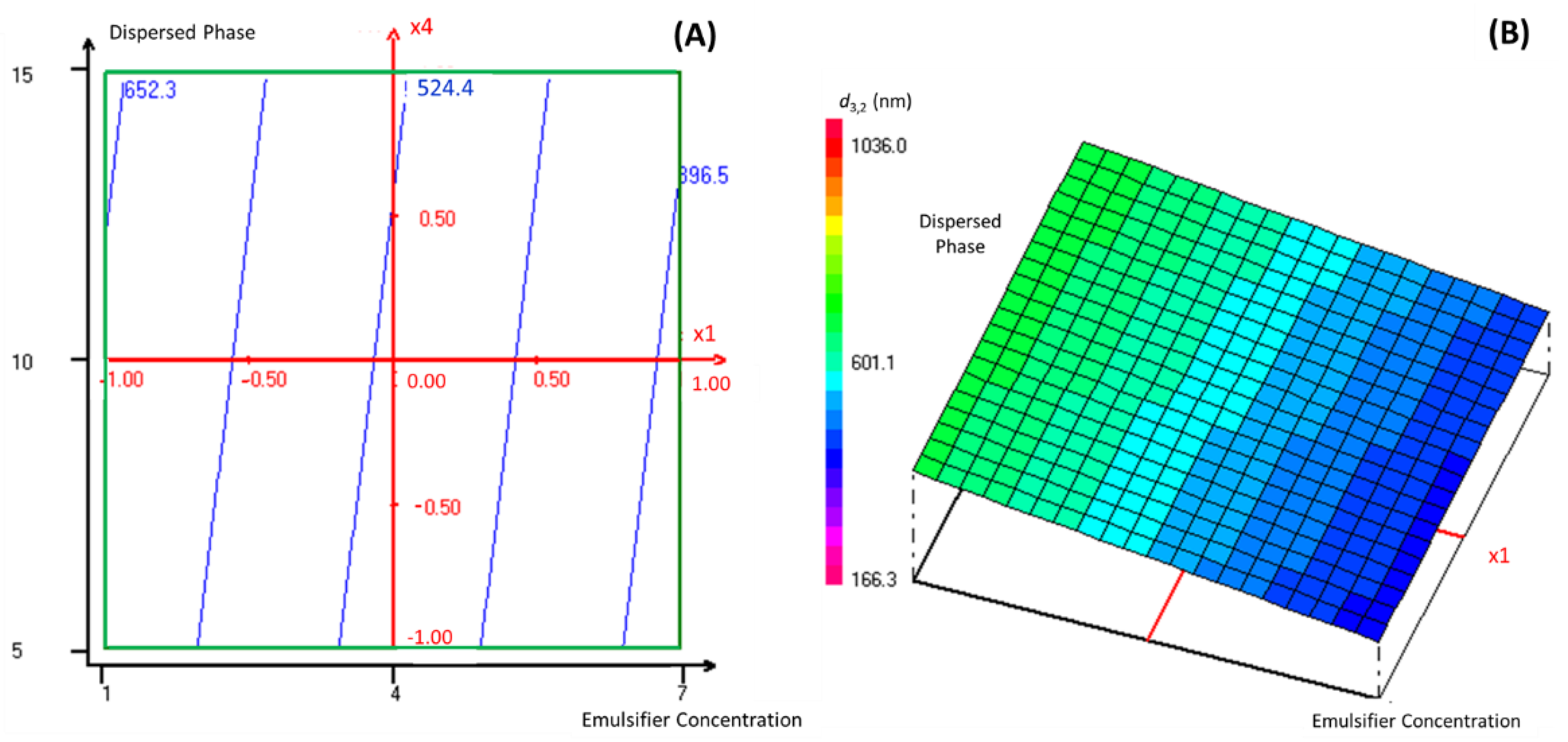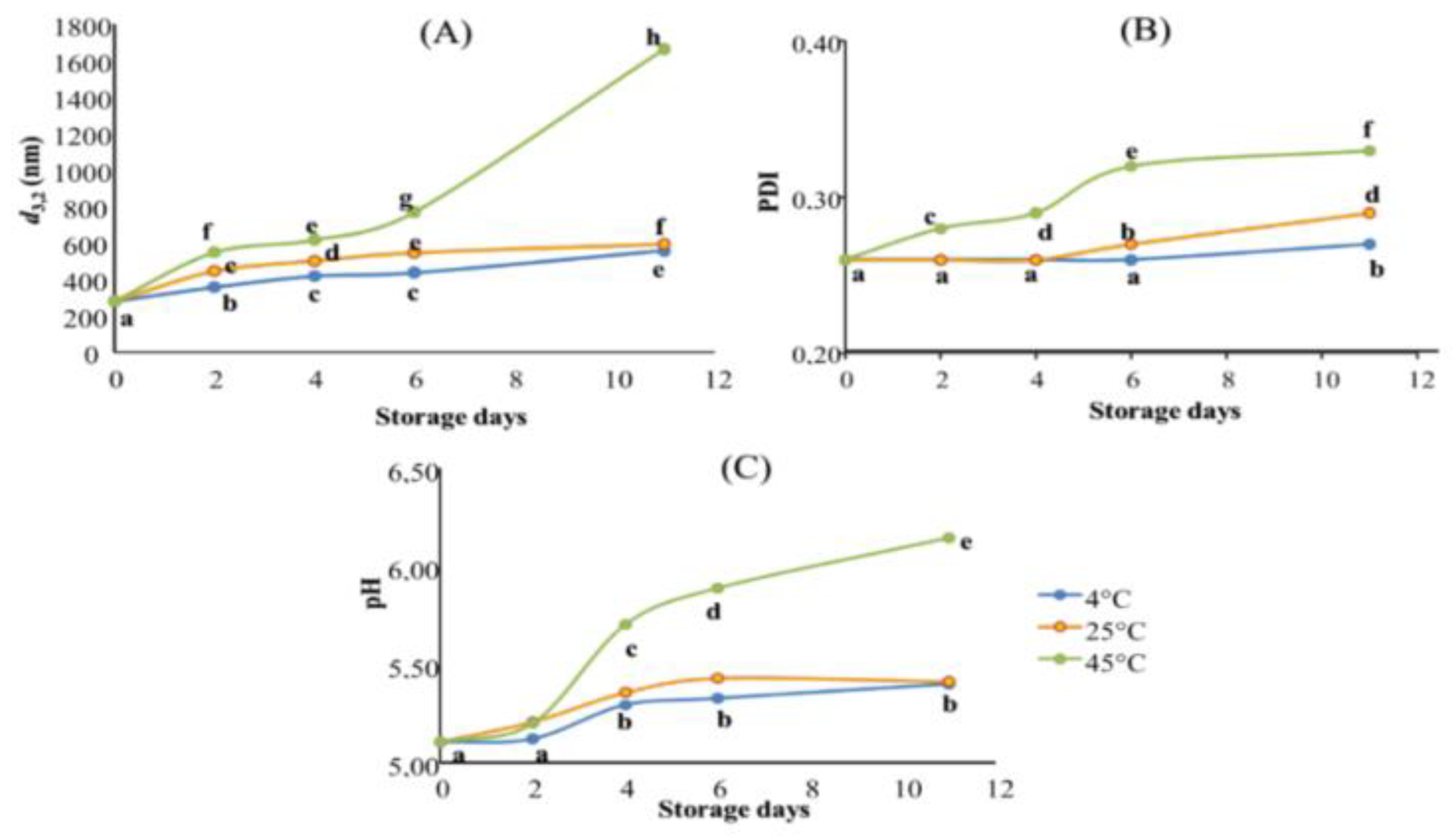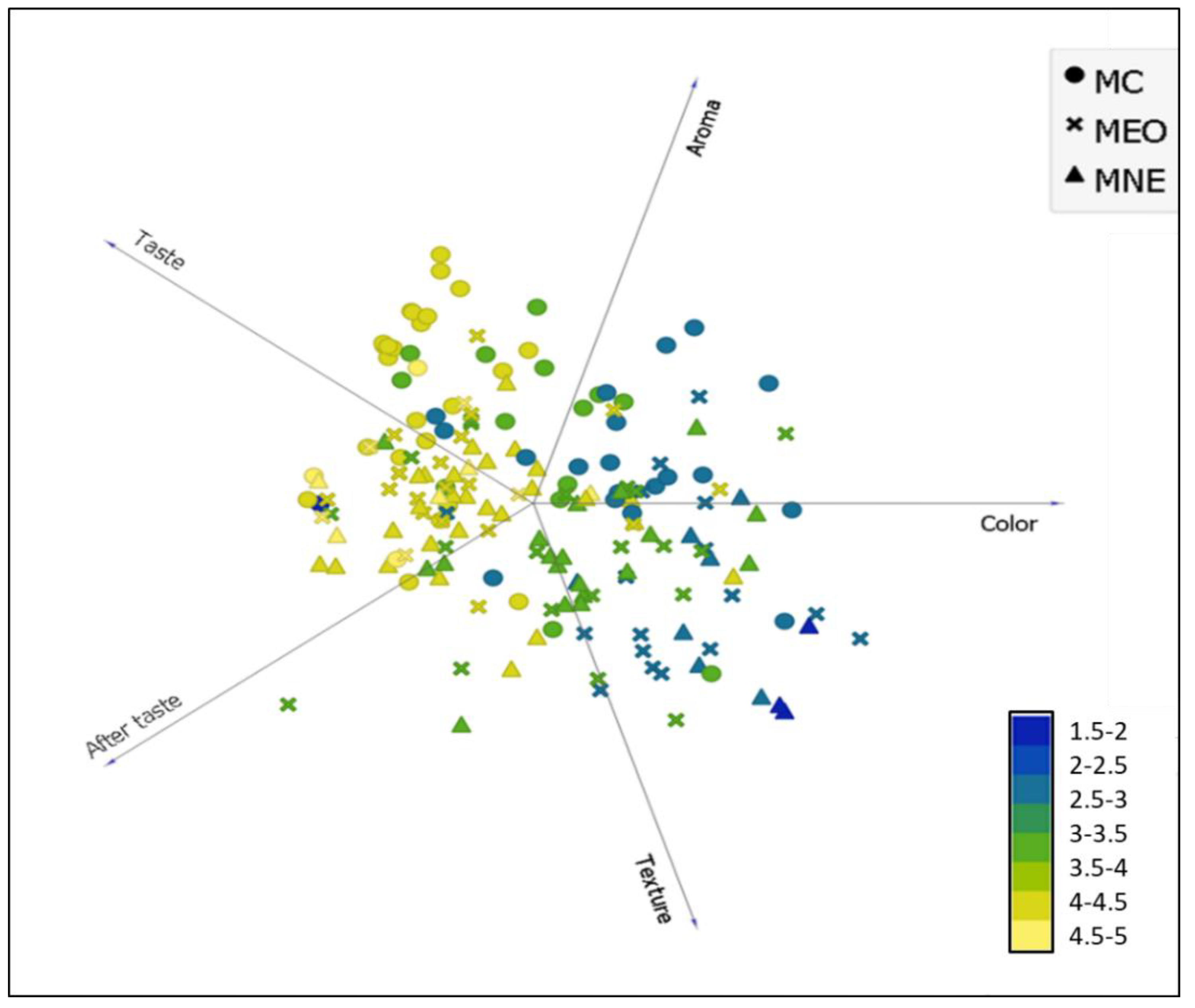Essential Oil Stabilisation by Response Surface Methodology (RSM): Nanoemulsion Formulation, Physicochemical, Microbiological, and Sensory Investigations
Abstract
:1. Introduction
2. Results and Discussion
2.1. TEO Nanoemulsion Formulation
2.1.1. Model Fitting and Statistical Analysis
2.1.2. TEO Encapsulation into Nanoemulsion-Based Delivery System Using the Desirability Approach
2.2. TEO Nanoemulsion Physic-Chemical Characterisation
2.3. TEO Nanoemulsion Stability Assessment
2.4. The Encapsulation Effect on TEO Biological Activities
2.4.1. Antiradical Activity Measurements
2.4.2. Antimicrobial Activity Measurements
2.5. The Encapsulation Effect on TEO Sensorial Impact on UHT Milk Enrichment
3. Materials and Methods
3.1. Plant Material, EO Extraction and GC-MS Analysis
3.2. TEO Encapsulation into Nanoemulsion-Based Delivery System (TNE)
3.2.1. Nanoemulsion Parameters
3.2.2. Response Surface Methodology Experimental Design
3.3. TEO Nanoemulsion Droplet Size Measurement
3.4. TEO Nanoemulsion Physicochemical Characterisation
3.5. TEO Nanoemulsion Stability Assessment
3.6. Encapsulation Effect on TEO Biological Activities
3.6.1. Antiradical Activity
3.6.2. Antimicrobial Activity
3.7. Encapsulation Effect on TEO Sensorial Impact
3.8. Statistical Analysis
4. Conclusions
Supplementary Materials
Author Contributions
Funding
Institutional Review Board Statement
Informed Consent Statement
Data Availability Statement
Conflicts of Interest
Sample Availability
References
- Vivas, R.; Barbosa, A.A.T.; Dolabela, S.S.; Jain, S. Multidrug-resistant bacteria and alternative methods to control them: An overview. Microb. Drug Resist. 2019, 25, 890–908. [Google Scholar] [CrossRef]
- Du, W.; Chen, H.; Xiao, S.; Tang, W.; Shi, G. New insight on antimicrobial therapy adjustment strategies for gram-negative bacterial infection: A cohort study. Medicine 2017, 96, 1–9. [Google Scholar] [CrossRef] [PubMed]
- Cerceo, E.; Deitelzweig, S.B.; Sherman, B.M.; Amin, A.N. Multidrug-resistant gram-negative bacterial infections in the hospital setting: Overview, implications for clinical practice, and emerging treatment options. Microb. Drug 2016, 22, 412–431. [Google Scholar] [CrossRef] [PubMed]
- Rolain, J.-M.; Abat, C.; Jimeno, M.-T.; Fournier, P.-E.; Raoult, D. Do we need new antibiotics? Clin. Microbiol. Infect. 2016, 22, 408–415. [Google Scholar] [CrossRef] [Green Version]
- Iseppi, R.; Mariani, M.; Condò, C.; Sabia, C.; Messi, P. Essential oils: A natural weapon against antibiotic-resistant bacteria responsible for nosocomial infections. Antibiotics 2021, 10, 417. [Google Scholar] [CrossRef]
- Falleh, H.; Jemaa, M.B.; Saada, M.; Ksouri, R. Essential oils: A promising eco-friendly food preservative. Food Chem. 2020, 330, 127268. [Google Scholar] [CrossRef]
- Mahdi, A.A.; Al-Maqtari, Q.A.; Mohammed, J.K.; Al-Ansi, W.; Cui, H.; Lin, L. Enhancement of antioxidant activity, antifungal activity, and oxidation stability of Citrus reticulata essential oil nanocapsules by clove and cinnamon essential oils. Food Biosci. 2021, 43, 101226. [Google Scholar] [CrossRef]
- Benjemaa, M.; Neves, M.A.; Falleh, H.; Isoda, H.; Ksouri, R.; Nakajima, M. Nanoencapsulation of Thymus capitatus essential oil: Formulation process, physical stability characterization and antibacterial efficiency monitoring. Ind. Crops Prod. 2018, 113, 414–421. [Google Scholar] [CrossRef]
- Jemaa, M.B.; Falleh, H.; Neves, M.A.; Isoda, H.; Nakajima, M.; Ksouri, R. Quality preservation of deliberately contaminated milk using thyme free and nanoemulsified essential oils. Food Chem. 2017, 217, 726–734. [Google Scholar] [CrossRef] [Green Version]
- Falleh, H.; Jemaa, M.B.; Neves, M.A.; Isoda, H.; Nakajima, M.; Ksouri, R. Formulation, physicochemical characterization, and anti-E. coli activity of food-grade nanoemulsions incorporating clove, cinnamon, and lavender essential oils. Food Chem. 2021, 359, 129963. [Google Scholar] [CrossRef] [PubMed]
- Balah, M.; Abd El Azim, W. Emulsions and Nanoemulsions Formation from Wild and Cultivated Thyme and Marjoram Essential Oils for Weeds Control. J. Plant Prot. Pathol. 2016, 7, 641–648. [Google Scholar] [CrossRef] [Green Version]
- Pongsumpun, P.; Tang, I.-M.; Wongvanich, N. Optimal control of the dengue dynamical transmission with vertical transmission. Adv. Differ. Equ. 2019, 2019, 176. [Google Scholar] [CrossRef] [Green Version]
- Myers, R.H.; Montgomery, D.C.; Anderson-Cook, C.M. Response Surface Methodology: Process and Product Optimization Using Designed Experiments; John Wiley & Sons: Hoboken, NJ, USA, 2016. [Google Scholar]
- Vivek, K.; Subbarao, K.; Srivastava, B. Optimization of postharvest ultrasonic treatment of kiwifruit using RSM. Ultrason. Sonochem. 2016, 32, 328–335. [Google Scholar] [CrossRef] [PubMed]
- Pierlot, C.; Pawlowski, L.; Bigan, M.; Chagnon, P. Design of experiments in thermal spraying: A review. Surf. Coat. Technol. 2008, 202, 4483–4490. [Google Scholar] [CrossRef]
- Jemaa, M.B.; Falleh, H.; Hammemi, M.; Ksouri, R. Essential Oil Encapsulation Into Nanoemulsion Based Delivery System: Optimization Assay. Int. J. Med. Plants Nat. Prod. 2021, 7, 12–18. [Google Scholar]
- Santos, M.G.; Bozza, F.T.; Thomazini, M.; Favaro-Trindade, C.S. Microencapsulation of xylitol by double emulsion followed by complex coacervation. Food Chem. 2015, 171, 32–39. [Google Scholar] [CrossRef]
- Zhou, Y. Research Progress in Preparation, Stability and Application of Nanoemulsion. J. Phys. Conf. Ser. 2022, 2152, 012044. [Google Scholar] [CrossRef]
- Cui, Q.; Liu, J.-Z.; Huang, Y.-Y.; Wang, W.; Luo, M.; Wink, M.; Fu, Y.-J.; Zu, Y.-G. Enhanced extraction efficiency of bioactive compounds and antioxidant activity from Hippophae rhamnoides L. by-products using a fast and efficient extraction method. Sep. Sci. Technol. 2017, 52, 1160–1171. [Google Scholar] [CrossRef]
- Demisli, S.; Mitsou, E.; Pletsa, V.; Xenakis, A.; Papadimitriou, V. Development and study of nanoemulsions and nanoemulsion-based hydrogels for the encapsulation of lipophilic compounds. Nanomaterials 2020, 10, 2464. [Google Scholar] [CrossRef]
- El Azim, W.M.A.; Balah, M.A. Nanoemulsions formation from essential oil of Thymus capitatus and Majorana hortensis and their use in weed control. Indian J. Weed Sci. 2016, 48, 421–427. [Google Scholar] [CrossRef]
- Nirmal, N.P.; Mereddy, R.; Li, L.; Sultanbawa, Y. Formulation, characterisation and antibacterial activity of lemon myrtle and anise myrtle essential oil in water nanoemulsion. Food Chem. 2018, 254, 1–7. [Google Scholar] [CrossRef]
- Sari, T.; Mann, B.; Kumar, R.; Singh, R.; Sharma, R.; Bhardwaj, M.; Athira, S. Preparation and characterization of nanoemulsion encapsulating curcumin. Food Hydrocoll. 2015, 43, 540–546. [Google Scholar] [CrossRef]
- Delmas, T.; Piraux, H.; Couffin, A.-C.; Texier, I.; Vinet, F.; Poulin, P.; Cates, M.E.; Bibette, J. How to prepare and stabilize very small nanoemulsions. Langmuir 2011, 27, 1683–1692. [Google Scholar] [CrossRef] [PubMed]
- Gupta, A.; Eral, H.B.; Hatton, T.A.; Doyle, P.S. Nanoemulsions: Formation, properties and applications. Soft Matter 2016, 12, 2826–2841. [Google Scholar] [CrossRef] [PubMed] [Green Version]
- Ribeiro, R.C.d.A.; Barreto, S.M.A.G.; Ostrosky, E.A.; Rocha-Filho, P.A.d.; Veríssimo, L.M.; Ferrari, M. Production and characterization of cosmetic nanoemulsions containing Opuntia ficus-indica (L.) Mill extract as moisturizing agent. Molecules 2015, 20, 2492–2509. [Google Scholar] [CrossRef] [PubMed] [Green Version]
- Rahn-Chique, K.; Puertas, A.M.; Romero-Cano, M.S.; Rojas, C.; Urbina-Villalba, G. Nanoemulsion stability: Experimental evaluation of the flocculation rate from turbidity measurements. Adv. Colloid Interface Sci. 2012, 178, 1–20. [Google Scholar] [CrossRef] [PubMed] [Green Version]
- Cheng, L.-C.; Hashemnejad, S.M.; Zarket, B.; Muthukrishnan, S.; Doyle, P.S. Thermally and pH-responsive gelation of nanoemulsions stabilized by weak acid surfactants. J. Colloid Interface Sci. 2020, 563, 229–240. [Google Scholar] [CrossRef] [PubMed]
- Nehme, R.; Andrés, S.; Pereira, R.B.; Ben Jemaa, M.; Bouhallab, S.; Ceciliani, F.; López, S.; Rahali, F.Z.; Ksouri, R.; Pereira, D.M. Essential oils in livestock: From health to food quality. Antioxidants 2021, 10, 330. [Google Scholar] [CrossRef]
- Jemaa, M.B.; Falleh, H.; Serairi, R.; Neves, M.A.; Snoussi, M.; Isoda, H.; Nakajima, M.; Ksouri, R. Nanoencapsulated Thymus capitatus essential oil as natural preservative. Innov. Food Sci. Emerg. Technol. 2018, 45, 92–97. [Google Scholar] [CrossRef]
- Landry, K.S.; Chang, Y.; McClements, D.J.; McLandsborough, L. Effectiveness of a novel spontaneous carvacrol nanoemulsion against Salmonella enterica Enteritidis and Escherichia coli O157: H7 on contaminated mung bean and alfalfa seeds. Int. J. Food Microbiol. 2014, 187, 15–21. [Google Scholar] [CrossRef] [PubMed]
- Benjemaa, M.; Hafsi, C.; Falleh, H.; Serairi Beji, R.; Ksouri, R. Full text–poster presentation Essential oils as food preservative: Encapsulation, biological activities, and sensory impact. In Proceedings of the 7th International Mediterranean Symposium on Medicinal and Aromatic Plants, Izmir, Turkey, 18–20 November 2021. [Google Scholar]
- Tahsiri, Z.; Niakousari, M.; Khoshnoudi-Nia, S.; Hosseini, S.M.H. Sensory evaluation of selected formulated milk barberry drinks using the fuzzy approach. Food Sci. Nutr. 2017, 5, 739–749. [Google Scholar] [CrossRef] [PubMed]
- Snoussi, M.; Noumi, E.; Punchappady-Devasya, R.; Trabelsi, N.; Kanekar, S.; Nazzaro, F.; Fratianni, F.; Flamini, G.; De Feo, V.; Al-Sieni, A. Antioxidant properties and anti-quorum sensing potential of Carum copticum essential oil and phenolics against Chromobacterium violaceum. J. Food Sci. Technol. 2018, 55, 2824–2832. [Google Scholar] [CrossRef] [PubMed]
- Falleh, H.; Trabelsi, N.; Bonenfant-Magné, M.; Le Floch, G.; Abdelly, C.; Magné, C.; Ksouri, R. Polyphenol content and biological activities of Mesembryanthemum edule organs after fractionation. Ind. Crops Prod. 2013, 42, 145–152. [Google Scholar] [CrossRef]
- Demšar, J.; Curk, T.; Erjavec, A.; Gorup, Č.; Hočevar, T.; Milutinovič, M.; Možina, M.; Polajnar, M.; Toplak, M.; Starič, A. Orange: Data mining toolbox in Python. J. Mach. Learn. Res. 2013, 14, 2349–2353. [Google Scholar]





| Exp | X1: Emulsifier Percentage | X2: Stirring Time | X3: Sonication Time | X4: Dispersed Phase Percentage | d3,2 (nm) | |
|---|---|---|---|---|---|---|
| Experimental | Predicted | |||||
| 1 | −1 (1%) | −1 (0 mn) | −1 (0 mn) | 1 (15%) | 648.7 | 660.98 |
| 2 | 1 (7%) | −1 (0 mn) | −0.5 (8 mn) | 0.83 (15%) | 490.0 | 470.08 |
| 3 | 1 (7%) | 1 (6 mn) | −1 (0 mn) | −1 (5%) | 746.4 | 736.63 |
| 4 | −1 (1%) | 1 (6 mn) | 1 (30 mn) | −1 (5%) | 1036.0 | 1046.92 |
| 5 | 1 (7%) | −1 (0 mn) | 1 (30 mn) | 1 (15%) | 463.0 | 451.88 |
| 6 | −1 (1%) | 1 (6 mn) | −1 (0 mn) | 1 (15%) | 1012.0 | 1027.53 |
| 7 | −1 (1%) | −1 (0 mn) | 1 (30 mn) | −1 (5%) | 663.5 | 680.38 |
| 8 | 1 (7%) | 1 (6 mn) | 1 (30 mn) | 1 (15%) | 779.5 | 818.42 |
| 9 | 0 (4%) | 0 (3 mn) | 0 (15 mn) | 0 (10%) | 757.6 | 724.10 |
| 10 | 0 (4%) | 0 (3 mn) | 0 (15 mn) | 0 (10%) | 759.0 | 724.10 |
| 11 | 0 (4%) | 0 (3 mn) | 0 (15 mn) | 0 (10%) | 766.9 | 724.10 |
| TNE | Results | Units |
|---|---|---|
| Viscosity | 0.10 ± 0.01 | mPa/s |
| Refractive index | 1.35 ± 0.08 | - |
| pH | 5.10 ± 0.23 | - |
| Droplet diameter | 260.8 ± 1.52 | nm |
| PDI | 0.26 ± 0.02 | - |
| Turbidity | 20.51 ± 0.95 | - |
| Zeta Potential | −10.30 ± 0.78 | mV |
| Conductivity | 0.52 ± 0.06 | ms/cm |
| C | TEO | TNE | |
|---|---|---|---|
| % IC | <1 | 40.13 ± 1.58 a | 44.28 ± 2.04 b |
| Microbial Strains | IZ (mm) | Enhancement % | ||
|---|---|---|---|---|
| TEO | TNE | |||
| Gram+ Bacteria | Staphylococcus aureus | 7.00 ± 0.46 b | 10.33 ± 0.27 d | +47.62 |
| Enterococcus faecalis | 8.67 ± 0. 6 c | 10.33 ± 0.36 d | +19.23 | |
| Gram- Bacteria | Salmonella typhimurium | 6.00 ± 0.27 a | 8.67 ± 0.67 c | +44.44 |
| Pseudomonas aeruginosa | 7.67 ± 0.58 cd | 8.33 ± 0.77 c | +8.70 | |
| Yeast | Candida albicans | 7.67 ± 0.44 cd | 12.33 ± 0.46 e | +60.87 |
| Hedonic Scale | 1 | 2 | 3 | 4 | 5 | |
|---|---|---|---|---|---|---|
| Population distribution (%) | 2.19 | 23.5 | 28.96 | 37.7 | 7.65 | |
| Milk samples | MC | 0.55 | 10.38 | 10.38 | 13.31 | 2.48 |
| MEO | 0 | 9.29 | 7.65 | 9.84 | 1.84 | |
| MNE | 1.64 | 3.83 | 10.93 | 15.15 | 2.73 | |
| Symbol | Independent Variables | Actual Levels at Coded Factor Levels | ||
|---|---|---|---|---|
| −1 | 0 | 1 | ||
| X1 | % emulsifier | 1 | 4 | 7 |
| X2 | Stirring Time (min) | 0 | 3 | 6 |
| X3 | Sonication Time (min) | 0 | 15 | 30 |
| X4 | % dispersed phase | 5 | 10 | 15 |
| N° Exp | X1 | X2 | X3 | X4 | Emulsifier Concentration | Stirring Time | Sonication Time | Dispersed Phase |
|---|---|---|---|---|---|---|---|---|
| % | min | min | % | |||||
| 1 | −1 | −1 | −1 | 1 | 1 | 0 | 0 | 15 |
| 2 | 1 | −1 | −0.5 | 0.83 | 7 | 0 | 8 | 12 |
| 3 | 1 | 1 | −1 | −1 | 7 | 6 | 0 | 5 |
| 4 | −1 | 1 | 1 | −1 | 1 | 6 | 30 | 5 |
| 5 | 1 | −1 | 1 | 1 | 7 | 0 | 30 | 15 |
| 6 | −1 | 1 | −1 | 1 | 1 | 6 | 0 | 15 |
| 7 | −1 | −1 | 1 | −1 | 1 | 0 | 30 | 5 |
| 8 | 1 | 1 | 1 | 1 | 7 | 6 | 30 | 15 |
| 9 | 0 | 0 | 0 | 0 | 4 | 3 | 15 | 10 |
| 10 | 0 | 0 | 0 | 0 | 4 | 3 | 15 | 10 |
| 11 | 0 | 0 | 0 | 0 | 4 | 3 | 15 | 10 |
Publisher’s Note: MDPI stays neutral with regard to jurisdictional claims in published maps and institutional affiliations. |
© 2022 by the authors. Licensee MDPI, Basel, Switzerland. This article is an open access article distributed under the terms and conditions of the Creative Commons Attribution (CC BY) license (https://creativecommons.org/licenses/by/4.0/).
Share and Cite
BenJemaa, M.; Rahali, F.Z.; Falleh, H.; Beji-Serairi, R.; Megdiche-Ksouri, W.; Hamrouni, I.; Hammami, M.; Nehme, R.; Pereira, R.B.; Andrés, S.; et al. Essential Oil Stabilisation by Response Surface Methodology (RSM): Nanoemulsion Formulation, Physicochemical, Microbiological, and Sensory Investigations. Molecules 2022, 27, 7330. https://doi.org/10.3390/molecules27217330
BenJemaa M, Rahali FZ, Falleh H, Beji-Serairi R, Megdiche-Ksouri W, Hamrouni I, Hammami M, Nehme R, Pereira RB, Andrés S, et al. Essential Oil Stabilisation by Response Surface Methodology (RSM): Nanoemulsion Formulation, Physicochemical, Microbiological, and Sensory Investigations. Molecules. 2022; 27(21):7330. https://doi.org/10.3390/molecules27217330
Chicago/Turabian StyleBenJemaa, Mariem, Fatma Zohra Rahali, Hanen Falleh, Raja Beji-Serairi, Wided Megdiche-Ksouri, Ibtissem Hamrouni, Majdi Hammami, Ralph Nehme, Renato B. Pereira, Sonia Andrés, and et al. 2022. "Essential Oil Stabilisation by Response Surface Methodology (RSM): Nanoemulsion Formulation, Physicochemical, Microbiological, and Sensory Investigations" Molecules 27, no. 21: 7330. https://doi.org/10.3390/molecules27217330







